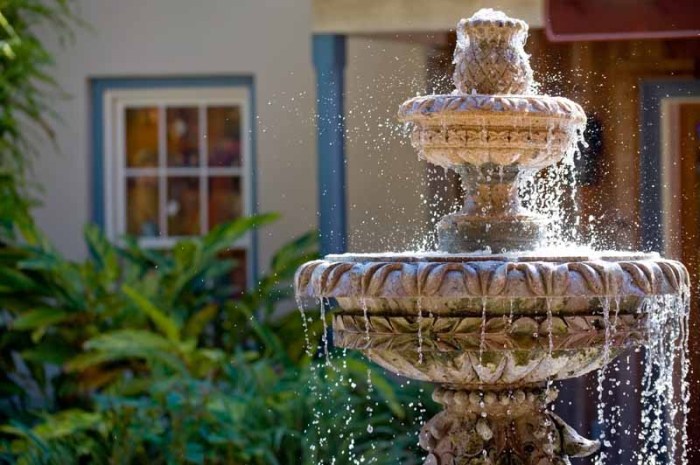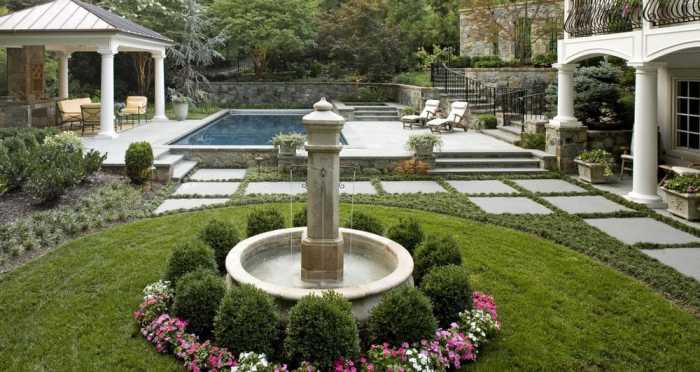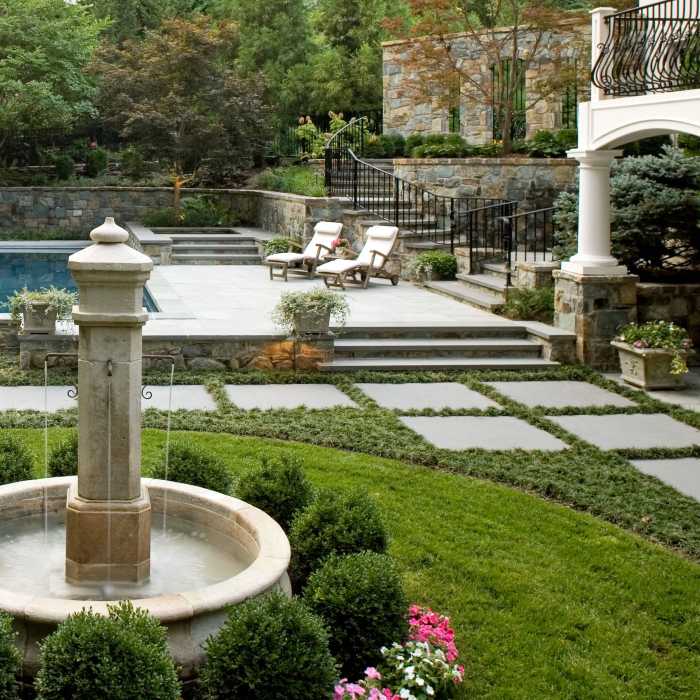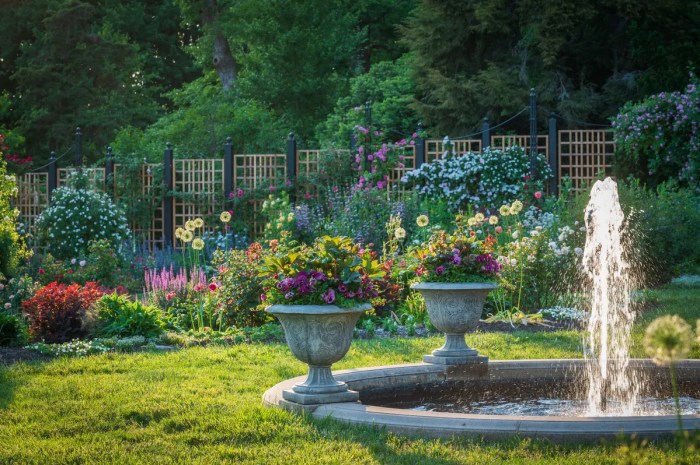The classic garden, punctuated by the soothing murmur of a fountain, represents a timeless pursuit of beauty and tranquility. These meticulously designed spaces, evolving over centuries, blend architectural elements with horticultural artistry to create oases of calm. From the formal geometries of Italian Renaissance gardens to the more naturalistic styles of the English landscape garden, the integration of water features, particularly fountains, has consistently elevated the aesthetic and sensory experience.
This exploration delves into the historical context, design principles, and practical considerations involved in crafting a classic garden with a fountain, revealing the intricate interplay of art, science, and nature.
The design of a classic garden with a fountain is not merely the placement of plants and a water feature; it’s a carefully orchestrated composition. Factors like sun exposure, soil type, microclimate, and even the prevailing winds influence plant selection and placement. Fountain design, encompassing style, material, and size, must complement the overall garden aesthetic, creating a harmonious and visually pleasing whole.
Understanding the historical evolution of garden design provides a framework for informed decision-making, ensuring the creation of a space that reflects both timeless elegance and contemporary sensibilities.
Defining the “Classic Garden with Fountain” Style

The classic garden with fountain represents a timeless aesthetic, blending horticultural artistry with architectural elegance. It evokes a sense of serenity and grandeur, drawing inspiration from centuries of design traditions across diverse cultures. These gardens are characterized by a formal structure, often symmetrical, with carefully curated plantings and a central focal point – the fountain – which serves as both a visual and auditory element.
Key characteristics include a strong emphasis on geometry, often utilizing straight lines, geometric flower beds, and precisely clipped hedges. The fountain itself is typically a carefully crafted structure, ranging from simple basins to elaborate sculpted pieces, and is often integrated with other water features like pools or canals. Plant selection reflects a preference for formality and order, with species chosen for their texture, color, and ability to be pruned and shaped into specific forms.
Architectural Styles Associated with Classic Gardens with Fountains
Classic garden designs with fountains are frequently associated with several distinct architectural styles. Italian Renaissance gardens, for example, are renowned for their terraced designs, elaborate fountains, and the use of statuary. French formal gardens, on the other hand, emphasize symmetry and grandeur, with long axes, meticulously manicured lawns, and impressive water features often incorporating multiple fountains and canals.
Baroque gardens extend the formality of French gardens, but often incorporate more elaborate and theatrical designs, using illusionistic techniques and surprising perspectives. English landscape gardens, while less formal, often incorporate fountains as focal points within their more naturalistic settings, demonstrating a shift towards a more romantic aesthetic.
Historical Context and Evolution of Classic Garden Design
The evolution of the classic garden with fountain reflects changing tastes and technological advancements. Ancient civilizations, such as the Romans and Greeks, created sophisticated water systems and integrated fountains into their gardens, emphasizing functionality and symbolic meaning. The Renaissance saw a resurgence of interest in classical forms, leading to the development of the Italian Renaissance garden style, which became highly influential.
The subsequent Baroque period witnessed a move towards even greater extravagance and theatricality in garden design, with fountains playing a central role in creating dramatic effects. The 18th century saw a shift towards the more naturalistic English landscape garden, although fountains continued to be incorporated, albeit often within a more relaxed and informal setting.
Hypothetical Classic Garden with Fountain Design
This hypothetical design envisions a smaller-scale classic garden, suitable for a residential setting. The design emphasizes symmetry and simplicity, drawing inspiration from Italian Renaissance principles.
| Feature | Description | Material | Dimensions |
|---|---|---|---|
| Central Fountain | A tiered fountain with a central basin and sculpted figures | Travertine stone, bronze | Height: 3m, Diameter: 2m |
| Formal Parterre | Geometrically arranged flower beds | Boxwood hedges, gravel paths | 10m x 10m |
| Plantings | Boxwood hedges, lavender, roses, and Italian cypress trees | Various | Varied, arranged symmetrically |
| Surrounding Walls | Low, curved walls defining the garden perimeter | Tuscan stone | Height: 1m, Length: 20m |
| Paving | Gravel paths with flagstone accents | Flagstone, gravel | Varied |
Fountain Types and Placement in Classic Gardens

The heart of a classic garden often lies in its water feature, a fountain that serves not only as a visual spectacle but also as a crucial element in shaping the garden’s overall aesthetic and atmosphere. The choice of fountain type and its placement within the garden are critical decisions that significantly impact the garden’s design and experience. Careful consideration of both aesthetic and practical aspects ensures a harmonious and captivating result.Fountain Types and Their Aesthetic ImpactThe selection of a fountain type is dictated by several factors, including the garden’s size, style, and the desired ambiance.
Different fountain types offer unique visual characteristics and practical considerations. Wall fountains, for instance, are ideal for smaller gardens or spaces where a freestanding fountain might overwhelm the area. Their verticality adds a sense of elegance and height, drawing the eye upwards. Freestanding fountains, on the other hand, command attention as central focal points, their size and design capable of creating dramatic statements.
Tiered fountains, with their cascading water, offer a dynamic visual experience, introducing movement and sound into the garden landscape. The choice between these styles often depends on the desired level of prominence and the available space. Practical considerations, such as water pressure and maintenance requirements, also play a crucial role in the selection process.Optimal Fountain Placement in Classic GardensThe placement of a fountain is paramount in a classic garden design.
Sightlines, focal points, and the integration with other water features all influence its optimal location. A well-placed fountain enhances the garden’s overall composition, guiding the viewer’s eye and creating a sense of flow and balance. For example, positioning a fountain at the end of a long vista creates a dramatic focal point, drawing the eye towards a visually arresting centerpiece.
Conversely, a smaller, more intimate fountain might be placed within a secluded seating area, offering a tranquil and reflective space. The integration of the fountain with other water features, such as ponds or streams, can further enhance the garden’s aesthetic appeal, creating a cohesive and harmonious water landscape. Careful consideration of these factors ensures the fountain’s placement maximizes its visual impact and contributes to the garden’s overall design.Fountain Styles, Characteristics, and Garden Settings
| Fountain Type | Visual Characteristics | Garden Setting | Maintenance Considerations |
|---|---|---|---|
| Wall Fountain | Vertical, elegant, often incorporates sculptures or decorative elements. Can be subtle or grand depending on design. | Smaller gardens, patios, enclosed spaces, alongside walls or hedges. | Regular cleaning of the basin and nozzle to prevent clogging. Periodic inspection for leaks. |
| Freestanding Fountain | Dominant focal point, varied styles from classical to modern, can incorporate various materials (stone, bronze, etc.). | Large gardens, open lawns, central locations requiring a strong visual statement. | More extensive cleaning and maintenance due to larger size and exposure. Potential for more significant repairs. |
| Tiered Fountain | Dynamic, cascading water creates visual and auditory interest, multiple levels add complexity. | Formal gardens, spacious areas where the multi-level design can be fully appreciated. | Regular cleaning of all basins and nozzles is crucial. Higher water usage compared to other types. |
| Basin Fountain | Simple, often circular or square basin with a central jet or spray. Can be integrated with other elements. | Variety of settings, easily adaptable to different styles, can be used as a subtle focal point or supporting feature. | Relatively low maintenance, requires regular cleaning of the basin and jet. |
Plant Selection and Arrangement in Classic Gardens
The careful selection and arrangement of plants are paramount in creating a truly classic garden. The aesthetic goals—symmetry, formality, and a sense of controlled natural beauty—dictate the choices made, from the species selected to their precise placement within the overall design. Understanding the growth habits, mature sizes, and aesthetic qualities of each plant is crucial for achieving the desired effect.
Plant selection for a classic garden hinges on creating a visually harmonious and balanced space. This involves considering factors such as color, texture, form, and the seasonal changes each plant will undergo. Careful consideration of plant heights is essential to create a layered effect, with taller plants forming a backdrop for shorter, more delicate specimens. The choice of plants also dictates the overall maintenance required to sustain the garden’s aesthetic.
Plant Species Commonly Used in Classic Gardens
Classic gardens frequently utilize a range of plant species, chosen for their aesthetic appeal and ability to thrive in the chosen environment. These plants often exhibit qualities of symmetry, repetition, and a controlled, formal look.
The following table categorizes some commonly used plants, noting their aesthetic qualities and maintenance needs. Remember that specific requirements can vary based on climate and soil conditions.
| Plant Type | Plant Species | Aesthetic Qualities | Maintenance Notes |
|---|---|---|---|
| Flowering Shrubs | Hydrangea macrophylla (Bigleaf Hydrangea) | Large, showy flower heads; various colors; lush foliage. | Requires regular watering and pruning to maintain shape and encourage blooming. Prefers slightly acidic soil. |
| Flowering Shrubs | Rosa spp. (Roses) | Fragrant blooms in a wide array of colors and forms; elegant foliage. | Requires regular deadheading, fertilization, and pest and disease control. Pruning varies depending on the rose type. |
| Hedging Plants | Buxus sempervirens (Common Boxwood) | Dense, evergreen foliage; easily shaped into formal hedges or topiary. | Tolerates pruning; requires regular watering, especially during dry periods. Susceptible to boxwood blight; monitor for disease. |
| Hedging Plants | Taxus baccata (English Yew) | Dark green, evergreen foliage; easily shaped and maintained. | Tolerates shade and pruning; slow-growing. Requires less frequent watering than boxwood. |
| Groundcovers | Vinca minor (Common Periwinkle) | Low-growing; dense, evergreen foliage; produces blue or white flowers. | Spreads readily; requires occasional pruning to control its growth. |
| Groundcovers | Pachysandra terminalis (Japanese Spurge) | Tolerant of shade; dense, evergreen foliage; provides good ground cover. | Low maintenance; requires minimal pruning. |
Planting Schemes for Classic Gardens with Fountains
Several planting schemes enhance the visual appeal of a classic garden with a fountain. The key is to create a balanced and harmonious composition, using plants of varying heights, textures, and colors. The fountain itself should serve as a focal point, with plants arranged to complement its form and enhance its visual impact.
One common approach involves creating a symmetrical arrangement around the fountain, using identical or mirroring plant groupings on either side. This creates a sense of order and formality, typical of classic garden design. Another approach uses a more naturalistic scheme, with plants arranged in gentle curves and flowing lines, softening the formal geometry of the fountain and surrounding structures.
Example Planting Plan: A Formal Border Near a Fountain
This plan Artikels a formal border planting scheme for an area 10 feet wide by 20 feet long flanking a central fountain. The plants are chosen for their ability to create a structured, layered effect, complementing the fountain’s elegance.
| Plant Name | Location | Quantity | Maintenance Notes |
|---|---|---|---|
| Taxus baccata (English Yew) | Back of border, evenly spaced | 6 | Annual pruning to maintain formal shape; occasional watering. |
| Hydrangea macrophylla (Bigleaf Hydrangea) | Mid-border, alternating with Yew | 6 | Regular watering; pruning after flowering to remove spent blooms; fertilize in spring. |
| Rosa ‘Iceberg’ (Climbing Rose) | Trained against a wall or trellis behind the Hydrangeas | 2 | Regular deadheading; winter pruning; pest and disease control. |
| Vinca minor (Common Periwinkle) | Front of border, to fill gaps | As needed | Occasional pruning to control spread. |
Materials and Construction in Classic Garden Design
The enduring beauty of a classic garden is inextricably linked to the careful selection and skillful application of its constituent materials. From the elegant sweep of a paved pathway to the imposing grandeur of a meticulously crafted wall, the materials chosen dictate not only the aesthetic appeal but also the longevity and practicality of the garden’s design. Understanding the properties and limitations of various materials is crucial for creating a harmonious and resilient landscape that withstands the test of time.
Paving Materials for Classic Garden Pathways
The choice of paving material significantly impacts the overall aesthetic and functionality of a classic garden’s pathways. Consideration should be given to factors such as durability, maintenance requirements, and aesthetic compatibility with the surrounding landscape.
- Natural Stone: Materials like limestone, flagstone, and granite offer unmatched durability and a timeless appeal. Their natural variations in color and texture contribute to a rustic charm. However, they can be expensive and require regular sealing to prevent staining and weathering. The irregular shapes of flagstone, for instance, require more skilled laying than the regular shapes of paving slabs.
- Brick: Bricks provide a classic, versatile paving option, available in a wide range of colors and patterns. They are relatively durable and easy to maintain, but can be more susceptible to frost damage in colder climates compared to stone. The use of different brick types and laying patterns can create visually interesting pathways.
- Gravel: Gravel pathways offer a more informal and permeable option, allowing water to drain easily. They are relatively inexpensive and easy to install, but can be less durable and require regular topping up to maintain their appearance. Different gravel sizes and colors can provide varied aesthetic effects.
Construction of Retaining Walls in Classic Gardens
Retaining walls are essential elements in many classic gardens, used to create level terraces or to manage slopes. The choice of construction method depends on the height and scale of the wall, as well as the surrounding environment.
- Dry-Stone Walling: This traditional technique involves stacking stones without mortar, creating a rustic and visually appealing wall. It relies on careful selection and placement of stones to ensure stability. This method is best suited for low to medium height walls in areas with good drainage.
- Mortar-Bound Walling: This method utilizes mortar to bind the stones together, offering greater stability and allowing for taller walls. The choice of mortar color and the type of stone used significantly influence the wall’s aesthetic appearance. This construction method is more durable than dry-stone walling and suitable for a wider range of heights and environmental conditions.
- Concrete Walls: Concrete walls offer a robust and cost-effective solution, especially for taller retaining walls. However, they can be less aesthetically pleasing than stone walls unless carefully finished and potentially require additional landscaping to blend with the surrounding environment. Different finishes can be applied to concrete walls to improve their appearance.
A Classic Garden Wall: A Visual Description
Imagine a weathered limestone wall, approximately 1.5 meters high, enclosing a secluded portion of the garden. The stones, varying in size and shade from pale cream to deep ochre, are carefully mortared together, creating a slightly uneven surface that reflects the natural variations in the stone. The mortar, a subtle grey-beige, almost disappears into the stonework, allowing the natural texture and color of the limestone to dominate.
A delicate tracery of ivy climbs sections of the wall, softening its hard lines and adding a touch of verdant life. The overall effect is one of quiet elegance and timeless beauty, a testament to both the skill of the craftsman and the enduring quality of natural materials. The subtle play of light and shadow across the textured surface adds depth and interest, creating a visual feast that changes throughout the day.
Illustrative Examples of Classic Gardens with Fountains

Classic gardens featuring fountains represent a sophisticated blend of horticultural artistry and hydraulic engineering. The careful selection of plant species, the strategic placement of the fountain, and the overall design create an atmosphere of tranquility and elegance. Examining specific examples illuminates the diverse ways these elements can be combined to achieve unique aesthetic effects.
Examples of Classic Garden Designs Incorporating Fountains
Three distinct examples showcase the versatility of the classic garden with fountain design. Each garden demonstrates different approaches to plant selection, fountain style, and overall aesthetic, yet all adhere to fundamental principles of balance, symmetry, and harmony.
| Garden Name | Fountain Description | Notable Plants | Overall Design Style |
|---|---|---|---|
| The Villa d’Este, Tivoli, Italy | A series of cascading fountains, including the renowned Organ Fountain, utilizing water pressure to create intricate water displays. The fountains are integrated into the terraced landscape, with water flowing down the hillside in a series of basins and jets. The water features range from formal to whimsical, reflecting the overall playful nature of the gardens. | Cypress trees, boxwood hedges, and various flowering shrubs and vines are strategically placed to complement the fountains and the overall Italian Renaissance design. The plants are carefully pruned and shaped to maintain a formal appearance. | Formal Italian Renaissance garden, characterized by symmetry, geometric patterns, and a strong emphasis on water features as focal points. The design employs axial lines of sight, leading the eye through the various terraces and fountains. |
| The Gardens of Versailles, France | The large reflecting pools and fountains of Versailles are iconic. The fountains, such as the Latona Fountain and the Neptune Fountain, are monumental in scale, employing complex hydraulic systems to create powerful jets and elaborate water displays. These are often integrated into the overall design with sculptures and other architectural features. | Formal hedges of boxwood and other evergreens, along with carefully arranged parterres of flowers, provide a structured backdrop to the expansive water features. The choice of plants emphasizes grandeur and formality, complementing the scale of the fountains and architecture. Ornamental trees, such as limes and chestnuts, are strategically placed for visual impact. | Formal French Baroque garden, known for its grandeur, symmetry, and the extensive use of water features as elements of power and control. The design emphasizes long vistas and axial lines, creating a sense of magnificence and order. |
| The Butchart Gardens, British Columbia, Canada | While not strictly adhering to a historical “classic” style, the Sunken Garden at Butchart Gardens features a large central fountain as a focal point. The fountain is relatively understated in design, creating a gentle and calming water feature rather than a dramatic display. | A riot of color and texture is created with thousands of meticulously chosen and arranged flowering annuals and perennials. The use of diverse plant textures and colors is key to the overall design. | A more romantic and naturalistic style, although still exhibiting a degree of formal planning. The overall effect is one of abundance and lushness, showcasing a wide range of plant species. The fountain acts as a calming center point within a diverse and vibrant landscape. |
Summary

Creating a classic garden with a fountain is a journey that combines historical understanding with practical horticultural knowledge. By carefully considering the interplay of architectural styles, plant selection, fountain design, and material choices, one can craft a space that evokes a sense of serenity and timeless beauty. The resulting garden is not simply a collection of elements, but a carefully orchestrated symphony of sight, sound, and scent, a testament to the enduring power of nature and human ingenuity.
The meticulous planning and attention to detail, informed by historical precedents and contemporary best practices, ensure a lasting legacy of horticultural excellence.
FAQ Overview
What are the common maintenance challenges of a garden fountain?
Regular cleaning to prevent algae growth and mineral deposits is crucial. Pump maintenance and occasional repairs are also necessary. Water level monitoring and replenishment are essential to prevent pump damage.
How can I ensure proper water circulation in my fountain?
Proper pump sizing relative to the fountain’s size and design is key. Regular cleaning of the pump and fountain basin prevents blockages. The fountain’s design should facilitate efficient water flow and prevent stagnant areas.
What are some eco-friendly options for a garden fountain?
Using recycled materials in construction, employing water-efficient pump technology, and incorporating native plants that require less watering are all environmentally conscious choices.
How do I choose plants that thrive near a fountain?
Select plants tolerant of moisture and potential splashing. Consider the microclimate created by the fountain, including increased humidity and potential for frost pockets.
